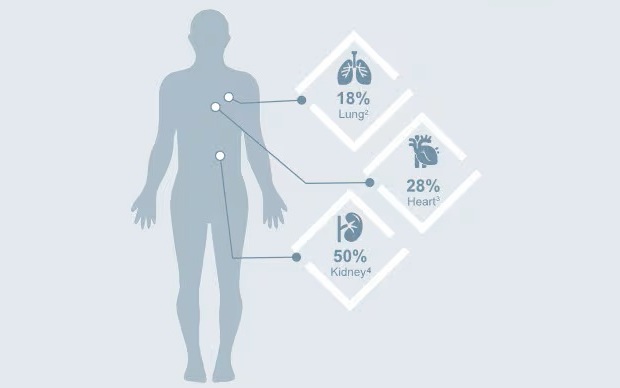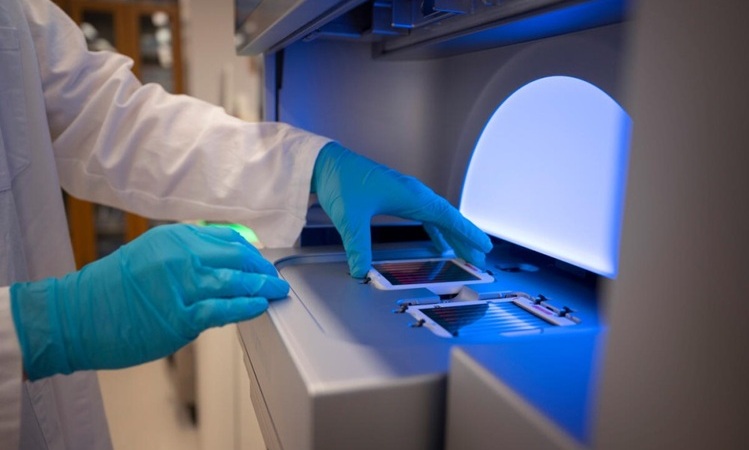Diagnostic Methods Compared for Human Granulocytic Anaplasmosis
By LabMedica International staff writers
Posted on 02 May 2019
Human granulocytic anaplasmosis (HGA) is a tick-borne intracellular bacterial infection caused by Anaplasma phagocytophilum. The disease is present in North America, Europe, and northern Asia, areas with Ixodes ricinus ticks, the primary vector for transmission to humans.Posted on 02 May 2019
Diagnosis requires the isolation of A. phagocytophilum in blood culture, the presence of morulae in polymorphonuclear cells after May Grünwald-Giemsa staining of peripheral blood smears, positive serologic results (seroconversion or high titer of specific antibodies), or a positive A. phagocytophilum polymerase chain reaction (PCR) result.

Image: A visualization of morulae in the cytoplasm of a granulocyte during examination of blood smears is highly suggestive of a diagnosis of Human Granulocytic Anaplasmosis (Photo courtesy of the US Centers for Disease Control and Prevention).
A large team of scientists collaborating with the University of Strasbourg (Strasbourg, France) conducted a prospective, multicenter study, and enrolled symptomatic patients living in Alsace, a region of northeastern France where tick-borne diseases are highly endemic. The investigators performed DNA extraction, PCR, and serologic testing blinded to sample identification. The PCR targeted the A. phagocytophilum msp2/p44 gene. They performed serologic testing using the Anaplasma phagocytophilum IFA IgG assay. Trained staff examined May Grünwald-Giemsa–stained smear preparations of whole blood samples for intracellular morulae.
Of the 130 patients, 19 had confirmed anaplasmosis diagnoses and 36 were controls with confirmed non-anaplasmosis diagnoses (infections with Borrelia burgdorferi, Epstein-Barr virus, cytomegalovirus, HIV, tick-borne encephalitis virus, Leptospira spp., Babesia spp., parvovirus B19, hantavirus, Francisella tularensis, Plasmodium spp., and Aeromonas spp.). Of the patients with HGA, 16/19 (84.2%) met the serologic criteria and 14/19 (73.7%) met the PCR criteria. Fever, the most frequent symptom (89%), was associated with joint and muscle pain. Cytopenia of platelets, neutrophils, or both (74%) and elevated liver enzyme levels (63%) were frequently present.
Calculations of the diagnostic value of each test method showed that PCR had a sensitivity of 0.74 and a specificity of 1 and blood smear staining had a sensitivity of 0.21 and a specificity of 1. Seroconversion or a 4-fold increase of antibody titer had a sensitivity of 0.32 and specificity of 0.97, an antibody titer >1:256 had a sensitivity of 0.58 and specificity of 0.97, and overall serology had a sensitivity of 0.84 and specificity of 0.97.
The authors concluded that the presentation of fever in a patient with a history of tick bite does not qualify for an anaplasmosis diagnosis; microbiological tests need to be performed. For anaplasmosis, PCR testing appears to be the most effective diagnostic tool. However, the sensitivity of PCR is <100%, and combining PCR with serologic testing at the first visit appears to be the best strategy for early diagnosis of acute anaplasmosis. In cases of high suspicion for HGA in patients without any diagnosis at the first visit, a second serologic test more than four weeks later can be helpful. A multiplex approach could also be used in such cases to look for differential diagnoses. The study was published in the May 2019 issue of the journal Emerging Infectious Diseases.
Related Links:
University of Strasbourg













